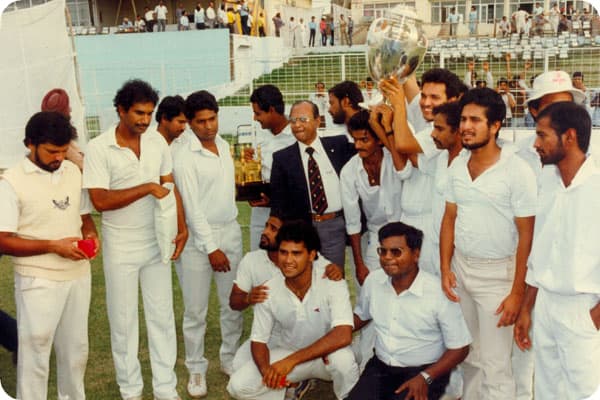MS Shanker
Hyderabad cricket, once a formidable force in Indian domestic cricket, has witnessed a steady decline over the decades. The recent Supreme Court observation that former players can better administer the game has sparked debate. However, as someone who has followed Hyderabad cricket for over four decades, I can confidently say this assumption is overly simplistic. In reality, the entry of former cricketers into administration has coincided with the downfall of Hyderabad cricket.
Under the stewardship of P.R. Mansingh, Hyderabad cricket flourished. Mansingh, who later managed the victorious 1983 World Cup Indian team, helped shape a generation of outstanding cricketers like M.L. Jaisimha, Abid Ali, Jayantilal, Govindraj, Krishna Murthy, and Abbas Ali Baig. These players were integral to Indian cricket, with many making it to national squads touring the West Indies and England under Ajit Wadekar’s captaincy.
However, the fortunes of Hyderabad cricket took a downturn once former players took charge of the Hyderabad Cricket Association (HCA). Shivlal Yadav, a direct beneficiary of Mansingh’s era, failed to halt the slide. Later, Arshad Ayub and Mohammad Azharuddin presided over what became a period of unchecked decline, plagued by corruption and mismanagement.
Despite Hyderabad producing players like M.V. Narasimha Rao, V.V.S. Laxman, and Ambati Rayudu—who made it to the national team through sheer talent—others were left out due to rampant nepotism and corruption. Promising young cricketers saw their careers derailed because selection was often dictated by connections and financial clout rather than merit.

The current state of Hyderabad cricket is distressing. Respected former players such as M.V. Narasimha Rao and Kawaljit Singh have expressed deep anguish over the game’s mismanagement. The HCA’s leadership appears either complicit or indifferent to the rot that has set in, leaving young players demoralized and disillusioned.
The late M.L. Jaisimha’s son, Vivek Jaisimha, raised concerns with the BCCI years ago about selectors being sidelined and pressured into picking undeserving players. Unfortunately, instead of corrective action, the problem has only deepened. The involvement of money in league championships and team selection is now an open secret, with bribes for team spots reportedly reaching as high as ₹50 lakh.
While the Supreme Court’s intervention in appointing former judge Nageswara Rao as an ombudsman was a step toward reform, the prevailing situation suggests that meaningful change remains elusive. The real question remains—who will clean up the mess?
Corruption within HCA is not limited to player selection. The construction of the Rajiv Gandhi International Stadium and other financial misdeeds have been marred by legal battles and ACB probes. Reports suggest that even politicians have entered the fray, buying league teams to wield influence over player selections, as it has become a lucrative proposition.
A former league player revealed that bribes starting at ₹25,000 were being demanded for a spot in HCA leagues. As players advanced, they had to pay even more, making it possible for mediocre cricketers to buy their way into state-level teams. This, in contrast to other states where young talent is nurtured, has contributed significantly to Hyderabad’s decline. It is no surprise that players like Ambati Rayudu and Hanuma Vihari chose to move elsewhere to further their careers.
Hyderabad was once known for making cricket more vibrant through prestigious tournaments like the Moin-ud-Dowlah Gold Cup. Today, even that legacy has been allegedly destroyed by corrupt administrators. The downfall of Hyderabad cricket can no longer be ignored—it is a crisis that demands urgent action.
M.V. Narasimha Rao, now settled in Ireland, supports the Supreme Court’s observations but insists that only players with unblemished integrity should be allowed to lead reforms. His recommendation is to begin by scrutinizing league teams and their eligibility, ensuring that no single individual controls multiple teams—an issue that has compromised both elections and selection processes.
In my view, some individuals who have proven to be honest and capable administrators—such as Venkteswaran (former Indian Airlines officer who served as Joint Secretary and later as in-charge Secretary), Jyoti Prasad, and Maheshwar Singh (who also played for the state Ranji team, though only a few matches due to the apathy of certain cricket stalwarts of his era, and later served as a coach for the state team)—along with a few others, could be a better bet if the HCA genuinely aims to eliminate corruption. However, this pack should be led by MV Narasimha Rao, whose immense contributions to state cricket were instrumental in Hyderabad’s first-ever Ranji Trophy victory (1987) in independent India.”
While P.R. Mansingh’s tenure is often remembered as a golden era, it must also be acknowledged that the seeds of corruption in HCA were sown during his time. The likes of Dayanand and Chalapathi, beneficiaries of that era, were among those who later contributed to the decay.
The current situation leaves Hyderabad cricket at a crossroads. Will genuine reformers step up to salvage the game, or will the rot continue unchecked? If real change is to come, it must start now—with those truly committed to the sport, not those who see it as a business opportunity.
Also read this: https://orangenews9.com/hyderabad-cricket-in-crisis-inside-the-rotten-core-of-hca-part-i/
Also, read this: Hyderabad Cricket in Crisis: Inside the Rotten Core of HCA – Part II – OrangeNews9






